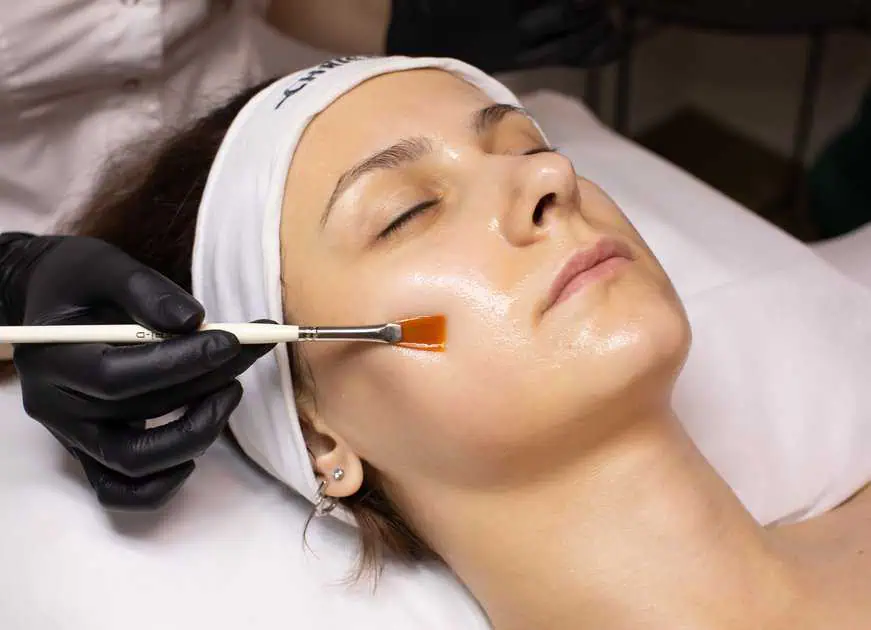Table of Contents
As the winter chill sets in, we battle an unwelcome side effect: dry, dull skin. The harsh weather can leave our complexions feeling tight, flaky, and lackluster. But what if there was a solution that could effectively combat winter dryness while revealing a glowing, rejuvenated appearance? Enter the chemical peel – a powerful treatment dermatologists and skincare experts increasingly recommend for addressing winter skin concerns.
Understanding Chemical Peels
What is a Chemical Peel?
A chemical peel is a skincare procedure that involves applying a solution to the skin, which causes the top layers to exfoliate and eventually peel off. This process reveals newer, fresher skin underneath. Chemical peeling for face treatments can address various skin concerns, including dryness, fine lines, uneven texture, and dullness.
Types of Chemical Peels
There are several chemical peel types available, each with varying strengths and benefits:
- Superficial peels are mild and use alpha-hydroxy acids (AHAs) or beta-hydroxy acids (BHAs).
- Medium peels: These often utilize trichloroacetic acid (TCA) to penetrate the skin.
- Deep peels: The strongest option, typically using phenol, for more dramatic results.
For winter skin concerns, superficial to medium peels are often recommended, as they can effectively address dryness without excessive downtime.
The Benefits of Chemical Peels in Winter
Combating Dryness
Winter air can strip moisture from the skin, leading to dryness and flakiness. A chemical peel for dry skin can help by:
- Removing dead skin cells that contribute to a dull, dry appearance
- Encouraging cell turnover, which can improve skin’s ability to retain moisture
- Allowing for better penetration of hydrating skincare products
Revealing Brighter, Smoother Skin
The exfoliating action of a chemical peel helps to:
- Even out skin tone and texture
- Reduce the appearance of fine lines and wrinkles
- Promote a healthy, radiant glow
Customizable Treatment
One of the advantages of chemical peels treatment is its versatility. A skilled practitioner can tailor the peel to your specific skin type and concerns, ensuring optimal results for your winter skin woes.
The Chemical Peel Process
Before the Peel
Prior to your treatment, your skincare professional will assess your skin and recommend the most suitable type of peel. They may also provide pre-treatment instructions to prepare your skin for the procedure.
During the Peel
The facial peeling process typically involves:
- Cleansing the skin thoroughly
- Applying the chemical solution
- Monitoring the skin’s reaction
- Neutralizing or removing the solution after a specific time
After the Peel
Chemical peeling before and after care is crucial for optimal results. Your provider will give you detailed instructions, which may include:
- Avoiding sun exposure and using sunscreen
- Keeping the skin hydrated
- Refraining from picking or peeling the skin
- Using gentle, non-irritating skincare products
Choosing the Right Chemical Peel for Winter
When selecting a chemical peel for winter skin concerns, consider:
- Your skin type and sensitivity
- The severity of your dryness or other skin issues
- Your desired level of results and tolerance for downtime
Popular options for winter skin include:
- Glycolic acid peels: Ideal for addressing dryness and promoting hydration
- Lactic acid peels: Gentle and hydrating, suitable for sensitive skin
- VI chemical peel: A medium-depth peel that can address multiple skin concerns
Expert Tips for Maximizing Chemical Peel Results in Winter
To get the most out of your chemical peels treatment during the colder months:
- Stay hydrated by drinking plenty of water
- Use a humidifier to add moisture to the air in your home
- Follow your practitioner’s pre and post-treatment skincare recommendations
- Consider scheduling a series of peels for cumulative benefits
Is a Chemical Peel Right for Your Winter Skin?
While chemical peels can be highly effective for addressing winter skin concerns, they may not be suitable for everyone. Factors to consider include:
- Skin type and sensitivity
- History of cold sores or keloid scarring
- Recent use of certain skincare products or medications
- Pregnancy or breastfeeding status
It’s essential to consult with a qualified skincare professional to determine if a chemical peel is the right choice for your winter skin fix.
Conclusion: Embrace Radiant Winter Skin
As we’ve explored, chemical peels offer a powerful solution for combating winter dryness and revealing a fresh, glowing complexion. By removing dead skin cells, promoting cell turnover, and improving hydration, these treatments can help you face the cold months with confidence.
If you’re ready to banish winter dryness and unlock your skin’s natural radiance, consider a chemical peel. At Natural Beauty Aesthetics, our experienced team can guide you through the process, ensuring a treatment plan tailored to your unique skin needs.
Don’t let winter take a toll on your complexion. Book your slot now and discover how a chemical peel can transform your winter skin. Your journey to a brighter, more hydrated complexion starts here!








